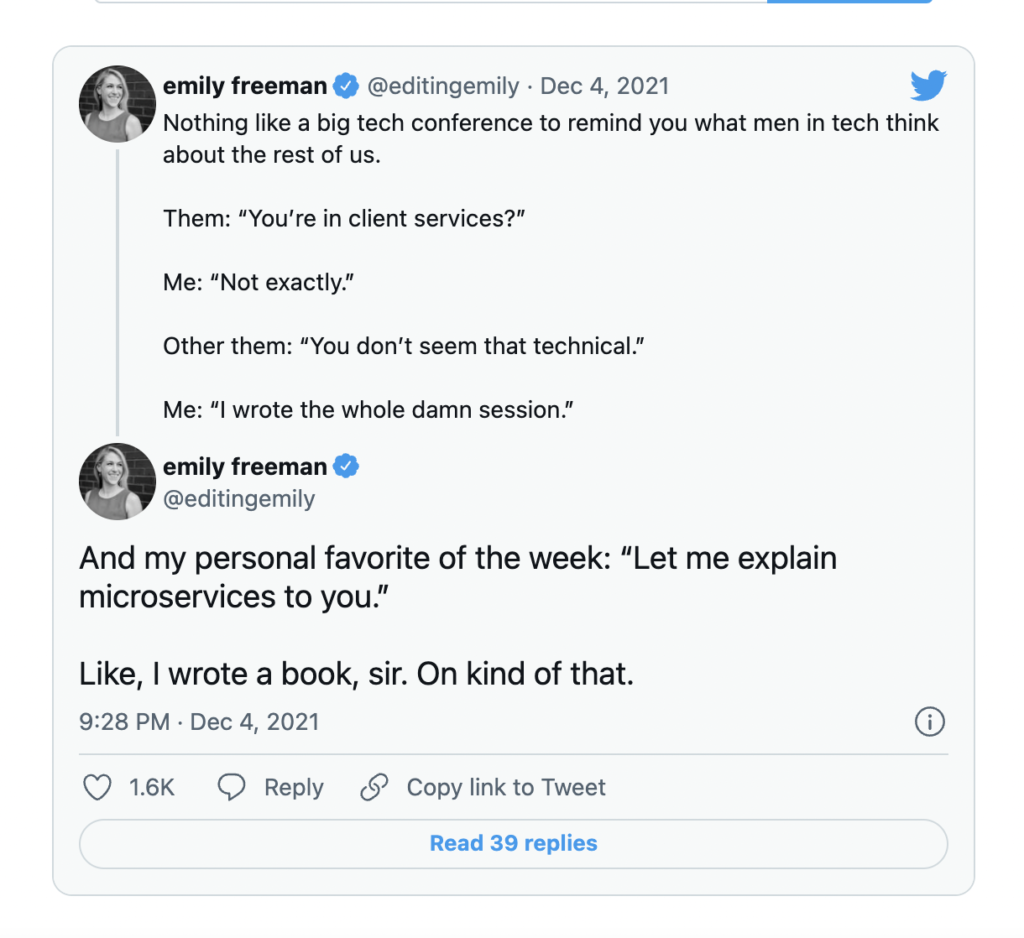This year’s AWS re:Invent was distinctive for two reasons: First, the huge excitement about being able to meet in person again after lockdowns. Second, one of our new marketing team members, Alina, attended the conference for her first time, as part of the IOD team. As a re:Invent “newbie,” Alina gave me the opportunity to see everything with fresh eyes and to hear the perspective of someone with a fresh view. This year’s conference was a great way to wrap up 2021, but also to understand where tech marketing is headed in 2022.
And what was most surprising to me about re:Invent in this regard, was how few companies were truly innovating; not in terms of technology—but in terms of their marketing.
Despite being ahead of the game on the tech scene, offering cutting-edge products and services, their marketing messages simply didn’t seem to be evolving at the same pace. Some of the company booths we visited were ones I’d visited in my previous years at re:Invent. But for many of these companies, it seemed as though almost nothing had changed in their marketing in the 10+ years I’ve been attending the conference.
What’s Wrong with a Consistent Message?
You might be thinking: What’s wrong with a consistent brand message? You’re right, brand consistency is important. But your tech solutions and services must keep up with industry trends and the needs of your users and customers (re:Invent, remember?), so you have something new to say every year, and even every quarter or month.
Alongside some truly impressive innovations—some with great marketing—there were just as many companies that seemed to have nothing new to say; the marketing felt “old fashioned,” using the same platitudes: “We only use AWS APIs; we don’t have agents installed on your machines, and we’re not intrusive”; or “we fully automate your backup operations.”
Missing were case studies showcasing their ability to address a particular niche. There was nothing to really make them stand out. No matter the vertical, so many of the booths and brochures I’d collected seemed identical.
If your messaging sounds the same as last year; or worse, if it sounds the same as every other marketing message in your niche, you’re selling yourself short!
I have no doubt that there’s a place for these products on the market, but for many of these companies, there is a real need to rethink or “reinvent” their marketing and content strategies in order to renew the discussion with the target audience and not get lost in the sea of fluff content in the market. Similarly, each vertical—whether cloud security, , or —seemed to be showcasing a parade of features that could have potentially stood out from the competition, but were often masked in buzzwords.
For the security companies, the important themes were “business continuity” and “resilience.” Ransomware was big this year, and many companies had innovative products, but much of the marketing material made it hard to differentiate them from each other.
Some of that is inevitable at such a large conference with so much to digest. But as a marketing professional, it seemed to me that there were missed opportunities to dive deeper into the technological innovations and apps that were unique to each company.
This, I realized, is the great divide, the main reason that IOD exists, in fact.
The marketing departments of these companies are often too siloed or simply staffed with marketers and writers who aren’t steeped in the technology. On the one hand, it truly is important to keep a strong focus on the benefits of the technology, rather than going on a feature binge. On the other hand, without going into the actual innovation, your company can sound exactly like the competitors and miss the opportunity to really shine.
Alina served as a great sounding board for all of that. Checking in with her, she was thrilled to get deeper insight into a number of verticals she knew less about, but when I asked her which vendors stood out in each niche, she admitted that she would have liked to hear more real technical cases and see more demos.
While many of the sales engineers at the booths were very knowledgeable, it seemed their initial presentation was glossy, and it was only when we asked deeper questions that we could actually differentiate one vendor from the other. The marketing materials often just didn’t go deep enough. On the surface, very few stood out from the others in terms of a particular feature, niche case, or technological breakthrough. However, she pointed out, in a market so saturated, rising above the noise really does take a special effort and a creative marketing team with deep tech know-how.
“Working with the IOD team, I know I can always trust they’ll deliver what I need.”
– Rafi Kretchmer, Check Point
Unique Messaging: It’s All in the Tech and Breaking Down Silos
Hiring top tech professionals is what IOD is all about. Although we fly a marketing banner, we focus on ensuring each and every one of our clients stands out. No matter how saturated the market is, we take the time to really understand the innovation offered by each of our clients. We do the market research on the competition; we focus on what real tech experts want (i.e., expert-based content), and we drill down on key differentiating factors. We care about the technology, because that’s where our clients put most of their efforts, and that’s where they are going to shine.
Even when it comes to C-level content, a “content writer” is not enough. Today’s C-suite is much more technically savvy than the executives a decade ago. The world has changed, and so have the top managers. The content needs to be based on real knowledge, be reliable, and speak to everyone in the decision-making chain, and they often scrutinize the tech details.
One of the simple solutions for tech companies is to break down the silos between the marketing and R&D teams. Management should encourage and even make it mandatory for the marketing team to attend new feature demos and other appropriate dev team meetings. For those on the marketing team with less technical backgrounds, budgeting for education in the relevant technical fields can go a long way. At IOD, we invest in educating our marketers and writers on tech, and our tech experts on marketing, content, and blogging.
But not all of your marketing team needs to know the tech—after all, digital marketers already have a lot of technical details to master, and they aren’t directly responsible for the messaging. If you are going to focus on one area of your marketing to upgrade, your content team should be priority.
Your content writers and expert contributors are on the front lines in terms of the messaging to the customers. It may be wise to have them spend some time with the support team, doing technical documentation, or in regular product management meetings.
Respecting the Tech Experts: No Matter What They Look Like
And while not about the messaging, another unfortunate but important observation we made was the still-unresolved issue of gender inequality. Women often fill marketing roles in the technology field, but even when they are highly versed in tech, gender stereotypes can prevent them from getting the respect they deserve. At many of the booths where Alina took the lead in asking about the technology, the sales engineer addressed all of his answers to me. Being confronted with this blatant discrimination seemed out of place. It was obvious that she knew what she was talking about (At IOD we hire the best, regardless of demographic aspects.), yet the man she was addressing didn’t see it.

Alina mentioned that this was hardly an anomaly at the show, sharing this tweet of one of the speakers, Emily Freeman ,who upon coming off the stage, was asked who had written her presentation and mentioning that she’d done a good job of presenting it. It’s well-known that re:Invent only accepts speakers who have prepared their own materials. It’s heartening to see talented people on stage.
While she had to face that kind of inappropriate comment, at least today we do have the public forum to offer a correction. I’m sure after the responses on Twitter, this gentleman won’t make the same mistake again.
Building a Tech Content Machine
It’s been another great year at IOD, a year of growth, and we know it’s because of our focus on expert-based tech content marketing. Quality tech content should be the foundation of your tech marketing operations from the earliest stages.
Every single person on our content team understands the ins and outs of technology and the specific market they write for. Based on IOD’s success over the years, we’re expanding and adding on to our capabilities in 2022.
Influencer marketing is a new capability we’re bringing on board. Of course, influencers are specific to each industry, and we’re working with some well-known tech bloggers and podcasters to ensure that we get exposure for our clients in the right markets. We’re also adding more research capability, focus groups, and validation with your target market.
In short, if you’re really looking to stand out from the competition in terms of your tech marketing, you need content and messaging that resonates with your audience. And who better to create that than the tech experts who fit your target audience profile?
We wish you all the best for a happy and successful 2022. And if you’re wondering what to expect in the tech world in the year ahead, be sure to check out IOD’s tech expert predictions for 2022.

